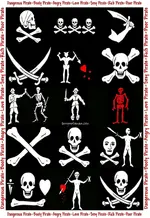grossmusic
Sr. Member
- Joined
- Jul 19, 2013
- Messages
- 348
- Reaction score
- 445
- Golden Thread
- 0
- Location
- Cape Canaveral
- Detector(s) used
- I detect the history: I've visited archives up & down the entire US East Coast, Bahamas, Jamaica, Kew, The Hague, etc. Have yet to go to Seville or S.American archives.
- Primary Interest:
- Shipwrecks
- #1
Thread Owner
Anyone know the actual origins of the jolly roger?
In my research, I found that it seemed to have appeared at the turn of the 18th century, & even in its all-black form was meant to be a symbol of "ol' Roger" aka THE DEVIL. In other words, it's a laughing devil.
Now, on tomorrow's Oak Island episode, a woman named Cornwall claims that the Templars created the Jolly Roger when fleeing annihilation in 14th-century France & created the skull & crossbones as a symbol for - get this - John the Baptist, their patron saint - because he was beheaded.
Is there any known connection between John the Baptist & the piratical Jolly Roger?
In my research, I found that it seemed to have appeared at the turn of the 18th century, & even in its all-black form was meant to be a symbol of "ol' Roger" aka THE DEVIL. In other words, it's a laughing devil.
Now, on tomorrow's Oak Island episode, a woman named Cornwall claims that the Templars created the Jolly Roger when fleeing annihilation in 14th-century France & created the skull & crossbones as a symbol for - get this - John the Baptist, their patron saint - because he was beheaded.
Is there any known connection between John the Baptist & the piratical Jolly Roger?
Last edited:





 This Chinese woman,yup a woman,commanded 300 pirate ships and between 20,000 to 40,000 pirates.
This Chinese woman,yup a woman,commanded 300 pirate ships and between 20,000 to 40,000 pirates.